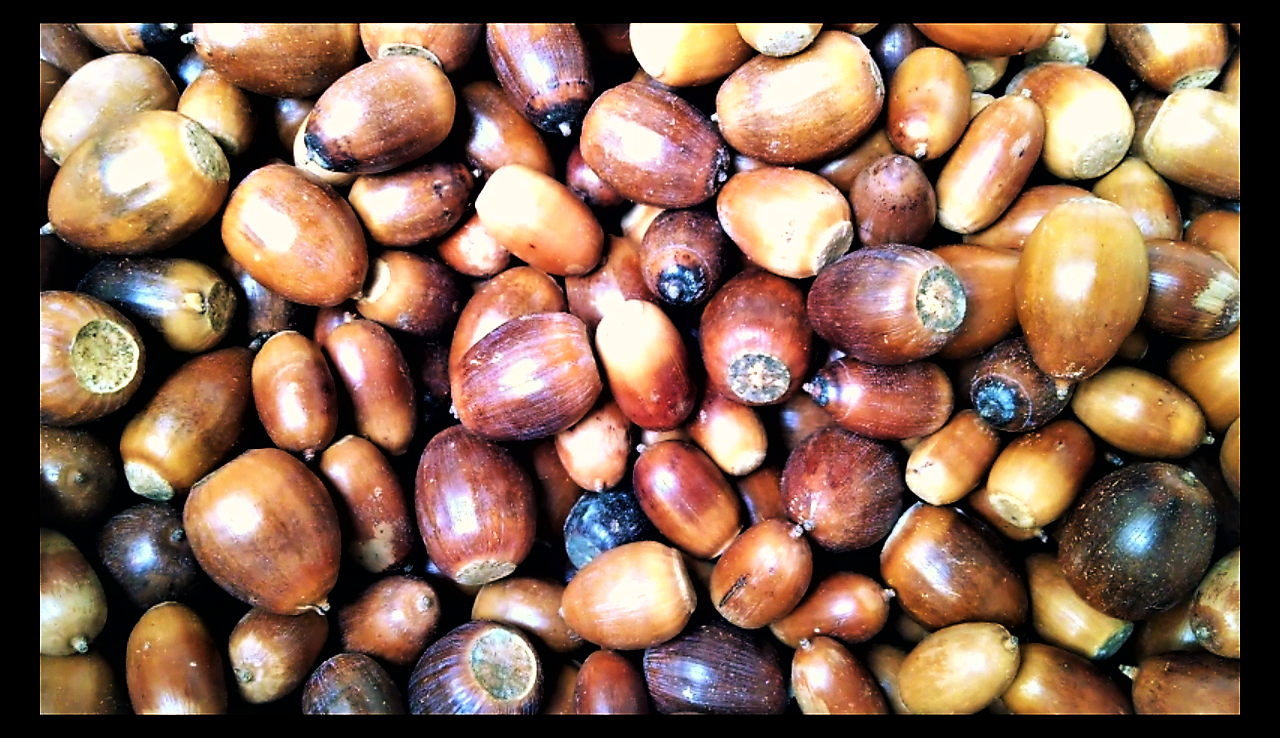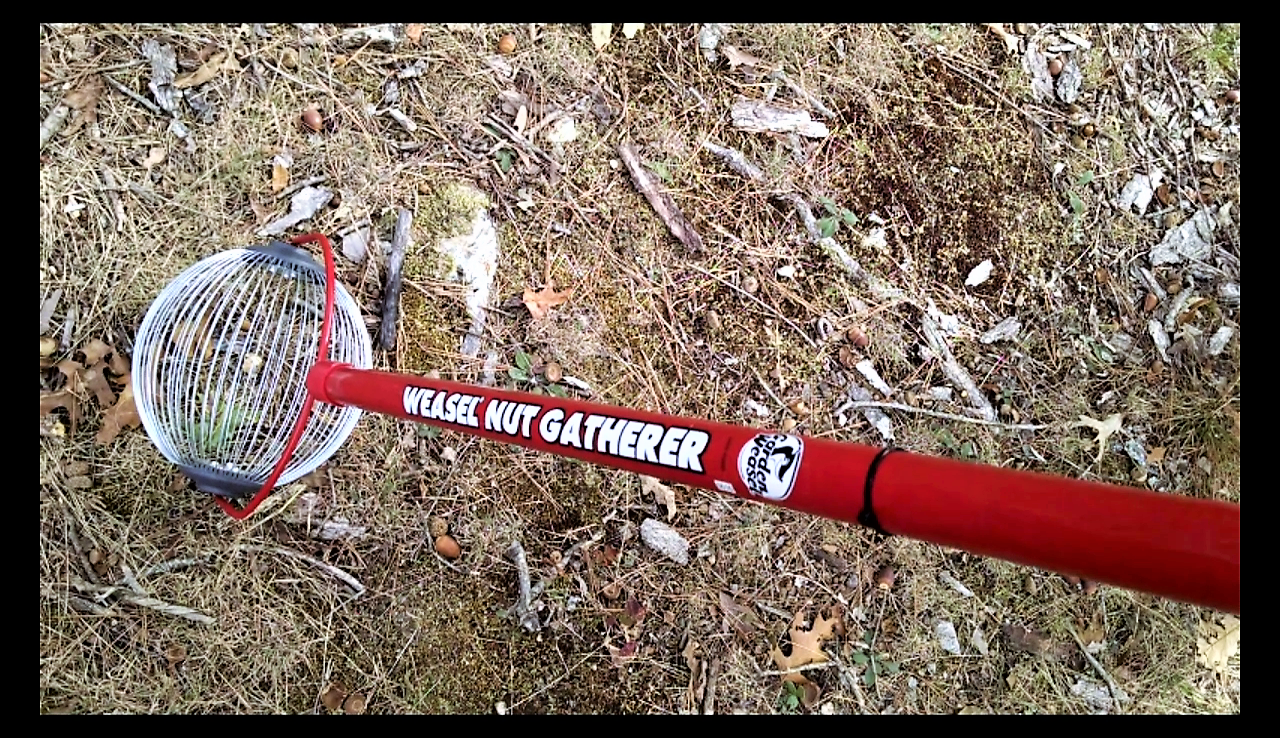A few weeks ago, I excitedly shared with you all about how we'd finally been able to turn acorns into bread (find the post here--> @slhomestead/first-ever-acorn-bread ). With that, I also promised to share the whole adventure that we took this fall in foraging for our flour! Even though we moved far too late to get a garden into the ground, we still had an amazing harvest, and we learned too much to keep it to ourselves. We also were able to do this entire process off-grid, with manual tools. So with that, here’s the first post in a little series of how we turned acorns into food.

Before we had moved, Andrew and I had made lots of plans for our land. With a desire for eventual food independence, we are going to implement lots of permaculture principles, plant a food forest, use hugelkultur, and reshape our hilly land with swales (how’s that for a heap of buzzwords??). We hadn’t originally thought of acorns as a food source, but after realizing that our 12 acres were covered with oak trees, we now see the huge blessing that’s already been provided all around us.
So, September and October brought literally hundreds of pounds of acorns to the ground, and we made ourselves busy collecting them. We are both really interested in foraging, so we had heard that acorns were useable as food with some processing. We had just never had the opportunity to really try it out! One of our guides for this nutty endeavor (sorry/not sorry for that pun) was an absolutely WONDERFUL book called Nature’s Garden. The author is Samuel Thayer, a guy who doesn’t just write about foraging, he lives it. He has probably foraged for and eaten every species of acorn in the United States, and he uses them as a large part of his daily diet. If there was ever anyone I’d want to learn foraging from, it’d be this guy! You can check out his website here: https://www.foragersharvest.com/
So, the first thing to know about collecting acorns is that there are TWO drops every season. What this means is that the oaks shed acorns twice…but it’s the SECOND drop that you want to forage from. In some amazingly-designed, not-yet-understood way, the oak tree is aware of what acorns aren’t good, and rids itself of the pest-infected and poorly-developed seeds early. This means that the first acorn drop is probably 99% bad nuts, and would be an incredibly disappointing foraging experience. We waited for the second drop of the trees we had identified with particularly large acorns, and at least 80% of those were gorgeous, perfect acorns.
At the beginning, we hunkered down under the most productive oak trees and picked up acorns by hand. Thayer recommends this, as it’s quite easy to sort through good and bad acorns by sight. If you do read his books (a highly-recommended endeavor), you’ll see that he has listed a near encyclopaedic rundown of how to tell a good acorn from a bad one (it basically comes down to inspecting the disc on the top for dark marks, watching for weevil holes, and ignoring ones with the caps still attached--those were nuts the tree rid itself of in the first drop).

Even so, we opted for a much faster approach, using the Weasel Nut Gatherer. Since we’ll also be planting hazelnut trees this spring, having a means of gathering a lot of nuts quickly is going to be a huge time-saver for us. We didn’t mind buying an extra tool if it would prove to be useful. AND IT IS.
(find it on Amazon, here-->
Small: http://amzn.to/2xWb7z3
Medium (this is the one I'm using): https://www.amazon.com/Garden-Weasel-...
Large: http://amzn.to/2l6Vl32 .
Though it’s indiscriminant, it really does pick up a lot of acorns quickly (you can watch it in action in our video below--start it at around 1:35). For acorns (and hazelnuts), the middle-sized one seemed to be the best choice
I found that the amount of extra things it picked up was no problem--when I cleaned the acorns, I was able to hand-sort them even more quickly than if I was doing it in the field. We’ll get into that in part two!
Once you have your haul of nuts, it’s important to get them drying or processed as soon as possible. Since acorns are rather naturally moist, they can go bad really quickly when piled in a bucket. It would be such a shame if your days of hard work collecting acorns resulted in a bucket of mold! We actually did lose some acorns this way (homestead life is busy, doncha know. I’ll make sure to do better next year!). If you can’t process them immediately, at least lay them out flat in a single layer somewhere where air can circulate around them. Also, be aware that acorn weevil larvae will appear soon--even some good-looking nuts are secretly host to the little grubby nut-destroyers. The grubs are not harmful in the least--they can’t re-infect other acorns, and they don’t bite (they’re just rather squishy looking). We actually collected them from the bottoms of our buckets and gave them to our awkward teenage chicks as a treat, so it was an excellent “problem” for us.
Acorn weevils and the acorns they've eaten
The Chicks say, "MORE OF THOSE, PLEASE."
So! I’ll get into how we turned this huge cache of nuts into edible flour in part two!
As a historical aside, I should mention that the idea of using acorns as an important part of the diet is nothing new, or even really all that adventurous. It’s just something that has been largely forgotten, I think. You can find acorns as a part of the gastronomical lexicon of many different countries across the world, from Italy to Korea, but none of the traditions fascinates me as much as that of the Native Americans. Many different nations--particularly the Hupa, Karok, Miwok, Pomo, and Yurok of northern California--use acorns as an integral part of the diet. The interesting thing about this is that many food cultures are centralized around a starchy staple crop, whether it be corn, rice, or wheat. In order to depend on those staples, however, you need to start living an agricultural lifestyle. Those northern tribes were able to maintain non-agricultural lives because acorns filled that starchy staple need. This gives me confidence that we can work enough acorns into our foraging diet that it could actually become a dependable crop for us as we get better at harvesting it every year! Even though we hope to plant our own wheat as soon as we get our swales established, it’s still wonderful to see that there is some sort of food already well established here.
It also gives me a bit of pause. I reflect on our decades in the city, and I remember that there were oak trees EVERYWHERE. The knowledge of how many toxins are found in flour, and how many resources are used to produce agricultural crops is in stark contrast to the realization that every September and October, hundreds of tons of edible food falls to the ground in every neighborhood and park. This food requires no input but what the Father gives it in sun and rain, so it’s certainly a super-sustainable source of sustenance (say that 5 times fast). I know I’m preaching to the choir when I say this to the homesteading community, but what would it do to the world if more people took advantage of these free food resources and started taking better responsibility for their own nourishment? What if we invested in long-term perennial food crops that are largely self-maintaining, rather than pouring resources (and chemicals) into annual food crops of debatable safety?
It’s food for thought, certainly.
Other places to find Simple Life Homestead Online!
Blog: http://www.simplelifehomestead.com/
YouTube: https://www.youtube.com/channel/UCwDzB6sjt8sZfB9hVUojxrQ
Facebook: https://www.facebook.com/SimpleLifeHomestead/
Twitter: @SLHomestead

